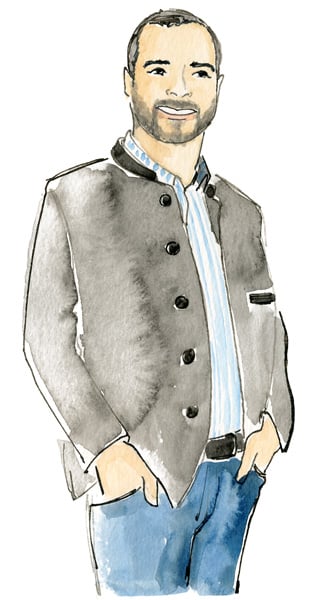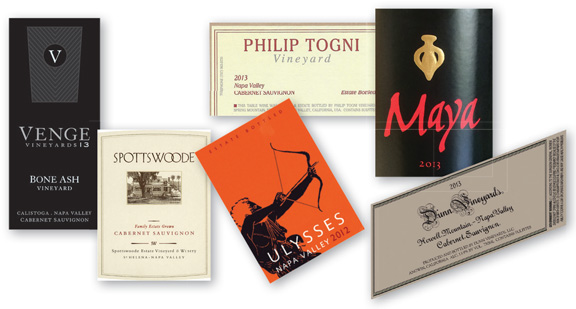“We don’t just have old vines,” Graeme MacDonald tells me. “We have vines our great-grandparents planted.”


Representing Napa’s stylistic evolution, these wines all come from estate vineyards, made or closely watched over by the people who own the land.
Today Graeme and his brother Alex make cabernet from these vines under their own MacDonald label. Though the brothers are modest about their wine, it’s a beautiful expression of benchland cabernet, with wonderfully fine tannins and abundant freshness.
Each generation has planted its own block of cabernet. The brothers planted the newest block just last year.
“It’s about the genealogy of the land,” MacDonald says. “Anyone who has been part of the land—and worked it before you—becomes almost familial. We live here [on the property] because, for me, it’s about rooting yourself in the land and developing depth of growth, rather than explosion of growth.”
In this case, the genealogy of the land goes back quite far: The vineyard was once a part of H. W. Crabb’s To Kalon, first planted in the 1880s. It’s since been broken into sections. Vines destined for Opus One grow right next door, and beyond those, there’s Mondavi’s extensive plantings. Closer to Highway 29 you’ll find Andy Beckstoffers’s portion of To Kalon. It’s some of the most coveted cabernet land in Napa.
MacDonald, his wife and their one-year-old daughter live in a one-bedroom farmhouse on the property, so that Graeme can farm the site himself. And some epic bottles of wine have been opened in those humble living quarters. The family’s long-standing vineyard relationship with Robert Mondavi gave MacDonald access to many old vintages of Mondavi cabernet; also, the MacDonald family often traded their own private bottlings with other now-legendary estates, building a unique collection of historically important Napa wines. So MacDonald’s been able to drink classics from every era of Napa Valley. His deep tasting experience informs his views on contemporary cabernet from Napa.
“I’m interested in wines that retain nobility,” he says. “Nobility to me, in the simplest sense, is a wine that implies power and intensity but remains light on the palate. It is a wine that represents a place and, in great circumstances, a history of place. They are wines that don’t just express a winemaker’s style, but tell a story. I also use nobility to describe tannins that on the first sip seems imperceptible—it is so integrated into the wine—but it builds with each sip to a point of power.” It’s a style of tannins that also means the wine can age. With his deep knowledge of Napa Valley, MacDonald has selected six contemporary cabernets that, for him, express nobility.
Of these six wines, he says: “They are each different and represent the place they came from. That is important to me.” They represent several different eras in Napa’s stylistic evolution, yet they have one thing in common: They all come from estate vineyards, made or at least closely watched over by the people who own the land. “If anything,” he says, “we can prove that there are still family farmer-winemakers in Napa Valley.”
1. Spottswoode St. Helena Napa Valley Cabernet Sauvignon
“It’s a historic estate,” MacDonald says. Spottswoode sits on the gravelly, well-drained soils of the warm St. Helena bench. George Schonewald, a German immigrant, first planted vines here in 1882. The Novak family bought the vineyard and the stately Victorian home ninety years later, selling the grapes before bottling their first Spottswoode estate cabernet in 1982. “It reminds me of old Napa,” MacDonald says. “People would come in from San Francisco and find this rundown property that was once this majestic estate, and commit to rebuilding it.
“Spottswoode is classic bench,” he continues—and a wine that’s always been a consistent and restrained expression of its vineyard. “It’s about grace and elegance.”
2. Philip Togni Napa Valley Cabernet Sauvignon
“There is a distinction between valley floor and mountains,” MacDonald explains. “The valley wines tend to be elegant and fresh. The mountain wines tend to be more tannic and powerful. The mountain sites are so California.” While the rise of Napa Valley cabernet started on the gravelly benchlands celebrated by André Tchelistche in the first half of the last century, by the 1970s the action had moved to the mountains.
“The French would never have had wines that tannic; they would fine them, or whatever, to so en them,” MacDonald says. “Part of what’s so important about these [mountain] wines is their classic mountain tannins.
“I associate Philip Togni with old-school Napa of the mountains,” MacDonald continues. “He made Chappellet in the classic era and was at Mayacamas and then started his own winery on Spring Mountain. From a mountain site, Togni’s wine has a little more power or savageness. That site is rocky and powerful but he always retains a sense of nobility to the wines.”
3. Dunn Vineyards Howell Mountain Napa Valley Cabernet Sauvignon
There are mountains, and then there are mountains—MacDonald emphasizes the important distinction between the mountains on the eastern side of the valley and those on the west. Thanks to the warmth of the afternoon sun, wines from the eastern side tend to be bigger in flavor and often more tannic than those from the west. Randy Dunn established his eponymous Howell Mountain winery in the late 1970s, and now grows 29 acres of cabernet. “I grew up hearing about how there is this ageable Napa cabernet, and that we should all cellar it,” MacDonald recalls. Dunn Howell Mountain was one of his first introductions to wine from Napa Valley.
“Dunn’s wine is a testament to this specific era of winemaking in Napa Valley.” Over Dunn’s career, trends moved Napa wines toward a lighter, more approachable style in the 1980s and then into the richer fruit-forward wines of the 1990s. Yet Dunn remained steadfast in his age-it-first approach. “It’s so dark, concentrated and reductive, brooding, tannic. His wines have a consistent expression with vintage variation. It’s a wine that has more to give with time in bottle, as opposed to being all up front.”
4 Ulysses Napa Valley Cabernet Sauvignon
“Ulysses is a reflection of the French coming to California to make wine,” MacDonald says. In the 1980s, French winemakers began to appear in Napa Valley. Christian Moueix launched Dominus—from a historic vineyard long owned by the Daniels family—at the start of the 1980s. He continues to farm that benchland vineyard just west of the town of Yountville, but in 2008 he purchased a parallel benchland site a short drive north, in Oakville, for his latest project, Ulysses. Launched with the 2012 vintage, the Ulysses site, like Dominus, is farmed without irrigation. “This shows the focused discipline of the Old World master’s approach that has always worked, but with California fruit expression. There is fruit on the nose but then it’s spiced on the mouth. It’s almost deceiving, in that the fruit makes it seem like it might be a bigger wine, but then it tightens up. To me, that is a sign of restraint: There is power and intensity with the tannins.”
5. Venge Napa Valley Bone Ash Vineyard Cabernet Sauvignon
In the 1980s, Nils Venge gained international attention for his Groth Reserve Cabernet. “Kirk [Nils’s son] grew up in the success of Groth and then went out and established his own thing with Venge,” says MacDonald, breaking ground on his Bone Ash Vineyard in Calistoga in 2010. For MacDonald, the Venge family’s multigenerational presence in the wine business is another example of legacy. More than that, MacDonald sees Venge’s Bone Ash Cabernet as a unique expression of site. The vineyard brings the advantages of benchland soils to the warmer temperatures of Calistoga, while Kirk delivers precision through his winemaking.
“Venge is a very focused wine,” MacDonald says. “It has ripeness and fuller flavors, with purity of variety and place. It’s from Calistoga, so it gets a little more sunshine and a little more heat, while retaining cabernet flavor. This is California wine, more on the powerful side, with blueberry and cassis, red cherry and spice, but it retains its freshness.”


6. Dalla Valle Napa Valley Maya
“Dalla Valle is part of the ‘cult’ phenomenon,” MacDonald says—it’s generous, ripe, expensive and highly allocated. And yet, “the inclusion of cabernet franc keeps the wine more floral. It’s mountainous and pretty.” In 1982, Gustav and Naoko Dalla Valle began planting their vineyards on a volcanic slope in eastern Oakville, at 400 feet of elevation. Their top wine, Maya, brings together cabernet franc with its offspring cabernet sauvignon.
Though ripeness can sometimes hide terroir, MacDonald argues that this wine is as much about site as it is about style. “On the eastern side of Oakville, Dalla Valle tends to get more afternoon sun,” he explains. “It’s a little bit riper and higher octane than these other wines. Everything is dialed up. So, it’s a true expression of where California has gone, which is only possible because of California sun, yet it retains freshness and quality with varietal character and site expression. “Also, it’s named Maya, after the daughter, and I love that.”
This story was featured in W&S Fall 2016.
illustration by Veronica Collington
Based in Sonoma, Elaine Chukan Brown serves as the American specialist for JancisRobinson.com. Their work also appears in World of Fine Wine, the fourth edition of the Oxford Companion to Wine and on their own site, WakawakaWineReviews.com. Prior to writing about wine, Chukan Brown was a philosophy professor specializing in ethics and social politics.
This story appears in the print issue of fal 2016.
Like what you read? Subscribe today.
















